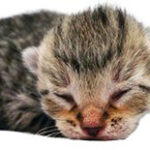Are you fascinated by felines and eager to learn more about different cat breeds? Or perhaps you’re looking to adopt a cat and want to explore the variety of breeds out there? This guide, featuring a collection of Cat Breeds Pictures, will help you identify various types of cats, from the common to the rare. We’ll showcase a range of breeds, similar to those we often see in our Adelaide clinic, and even touch upon some of the more unique and less frequently encountered ones.
Moggie, Tabby, Domestic Shorthair, or Companion Cat
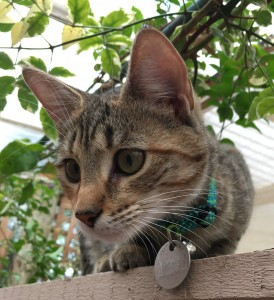 A classic tabby domestic cat breed with distinct markings
A classic tabby domestic cat breed with distinct markings
Let’s begin with the most frequently seen cat – the domestic cat, often referred to as a moggie or tabby depending on their coat pattern. It’s important to understand that “moggie” isn’t a breed itself, but rather a term for a cat of mixed or unknown ancestry. These cats are incredibly diverse, boasting a wide array of coat colors and patterns. Tabby markings, characterized by stripes, swirls, or spots, are particularly common and striking. These adaptable and charming cats are a testament to the beauty of natural feline variety.
Abyssinian
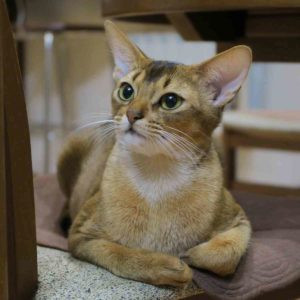 A regal Abyssinian cat showcasing its ticked coat and large ears
A regal Abyssinian cat showcasing its ticked coat and large ears
The Abyssinian breed stands out with its distinctive ear tufts and a uniquely “ticked” coat. This ticked coat means that each hair strand is banded with different colors, contributing to a rich, warm appearance. Reminiscent of wild African cat species, Abyssinians are known for their athletic builds and adventurous, curious personalities. They are energetic and intelligent cats that thrive on interaction and play.
Australian Mist
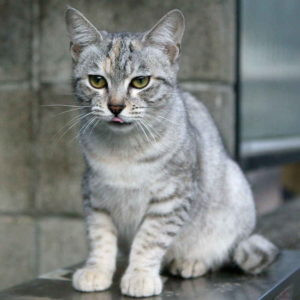 An Australian Mist cat with its characteristic spotted coat pattern
An Australian Mist cat with its characteristic spotted coat pattern
The Australian Mist, as the name suggests, is a breed that originated in Australia. Developed relatively recently, these cats are known for their stunning spotted or marbled coats which come in a variety of colors. They are medium-sized cats with a gentle and even-tempered nature, making them wonderful family pets.
Balinese
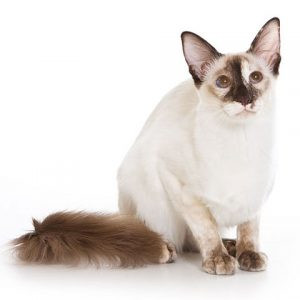 A graceful Balinese cat with long, flowing fur and blue eyes
A graceful Balinese cat with long, flowing fur and blue eyes
Despite their exotic-sounding names, both Balinese and Javanese cats have their origins in the United States. Balinese cats share a striking resemblance in body shape and personality with Siamese cats. The key difference lies in their coat; Balinese cats possess a longer, silky coat, especially prominent on their tail, giving it a plume-like appearance. They are intelligent, vocal, and affectionate cats who enjoy being part of the family.
Bengal
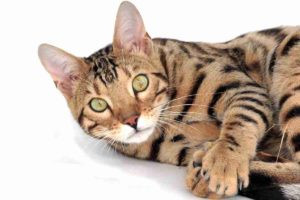 A Bengal cat displaying its wild-looking spotted coat
A Bengal cat displaying its wild-looking spotted coat
The Bengal breed is truly captivating with its wild appearance. Developed by crossing domestic cats with Asian Leopard Cats, Bengals boast spectacular spotted or marbled coats that resemble their wild ancestors. While they retain the striking looks, breeders have aimed to maintain the affectionate temperament of domestic breeds. However, Bengals are often more independent and active than some other domestic breeds and are typically recommended as indoor-only cats to protect local wildlife.
Birman
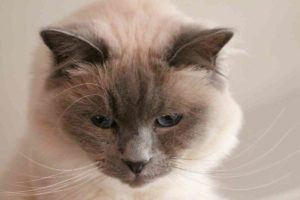 A Birman cat with its distinctive blue eyes and white "gloves" on its paws
A Birman cat with its distinctive blue eyes and white "gloves" on its paws
Birman cats are known for their gentle and easy-going personalities, combined with a luxurious, fine coat. They can sometimes be mistaken for long-haired Siamese or Himalayan cats due to their colorpoint markings. Distinctive features of the Birman are their striking blue eyes and contrasting white “gloves” on their paws, a charming characteristic of this breed.
Bombay
 A sleek Bombay cat with its black coat and striking golden eyes
A sleek Bombay cat with its black coat and striking golden eyes
Bombay cats are often described as “mini panthers” due to their glossy, jet-black coats and captivating golden or copper eyes. They have a rounded face and a muscular build. Bombay cats are known for their affectionate and playful personalities, often drawing comparisons to Burmese cats in their temperament.
British Shorthair
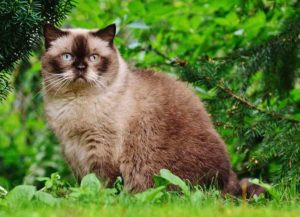 A classic British Shorthair cat with its dense, plush coat
A classic British Shorthair cat with its dense, plush coat
While frequently called the “British Blue” due to the popular blue-grey coat color, British Shorthairs actually come in a wide variety of colors and patterns. They are characterized by their dense, plush, short coat and a somewhat round face, hinting at a possible Persian ancestry. British Shorthairs are known for their calm and affectionate nature, making them wonderful companions.
Burmese
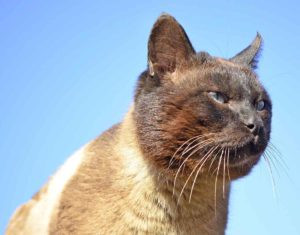 A Burmese cat with its elegant and sleek appearance
A Burmese cat with its elegant and sleek appearance
Burmese cats boast an attractive range of coat colors, from sable brown to platinum and champagne. Their personality is often described as exceptionally people-oriented, sometimes playfully referred to as “dog-like” in their loyalty and desire for interaction. Burmese cats are gentle, affectionate, and tend to be less timid in new environments compared to some other breeds.
Burmilla
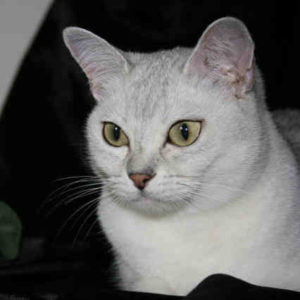 A Burmilla cat showcasing its silver coat and Burmese-like features
A Burmilla cat showcasing its silver coat and Burmese-like features
The Burmilla is a relatively rare breed that originated from an accidental crossing between a Burmese and a Chinchilla Persian. They inherit traits from both parent breeds, resulting in a stunning silver or golden shaded coat combined with the affectionate personality of the Burmese. Burmillas are elegant and gentle cats with expressive eyes.
Chinchilla
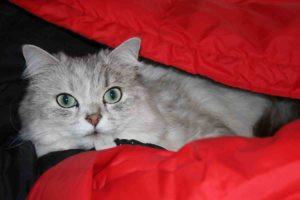 A fluffy Chinchilla cat with its long, silver-tipped coat
A fluffy Chinchilla cat with its long, silver-tipped coat
While not always recognized as an officially separate breed in all registries, the Chinchilla is widely regarded as distinct, particularly in Australia. Often considered a variety of Persian, Chinchillas possess unique features such as a longer nose, captivating greenish eyes, and a striking silver coat tipped with dark coloring. Their luxurious long coat requires regular grooming to maintain its beauty.
Cornish Rex
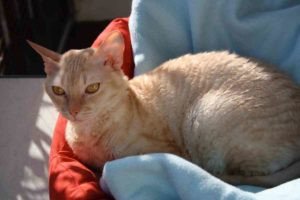 A Cornish Rex cat with its wavy, fine coat and large ears
A Cornish Rex cat with its wavy, fine coat and large ears
Cornish Rex cats are known for their unique, wavy coat. Unlike most cats, they lack the coarser outer layer of fur, resulting in a soft, suede-like texture. Despite the lack of a topcoat, they are not necessarily hypoallergenic. Cornish Rex cats have a slightly denser and more distinctly wavy coat than other Rex breeds, along with a slender, elegant body shape.
Devon Rex
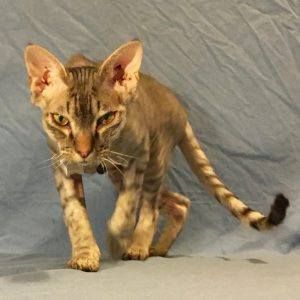 A playful Devon Rex cat with its pixie-like face and curly coat
A playful Devon Rex cat with its pixie-like face and curly coat
Devon Rex cats also possess a curly coat, but their wave is softer and looser than the Cornish Rex. Their coat is soft, short, and wavy, and can become quite sparse in some areas, especially during warmer months. Devons are renowned for their playful, social, and mischievous personalities. They are also characterized by their distinctive wide faces and prominent cheekbones, giving them an almost pixie-like appearance.
Egyptian Mau
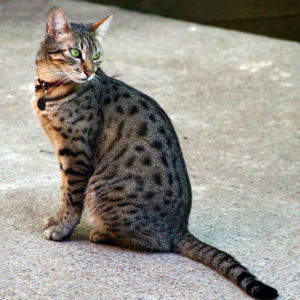 An Egyptian Mau cat showing its naturally spotted coat
An Egyptian Mau cat showing its naturally spotted coat
Egyptian Mau cats are a naturally spotted breed, meaning their spots are not the result of selective breeding but occur naturally. They are striking and elegant cats with a spotted coat that comes in bronze, silver, and smoke colors. Egyptian Maus are known for their intelligence, athleticism, and devoted personalities.
Exotic Shorthair
 An Exotic Shorthair cat with its plush coat and sweet face
An Exotic Shorthair cat with its plush coat and sweet face
Exotic Shorthairs are often described as “short-haired Persians.” They share the same gentle, affectionate, and cuddly personality as Persians, and also possess the distinctive flat face. The key difference is their short, dense, plush coat, which is much easier to manage than the long coat of a Persian, making them a popular choice for those who love the Persian look but prefer less grooming.
Maine Coon
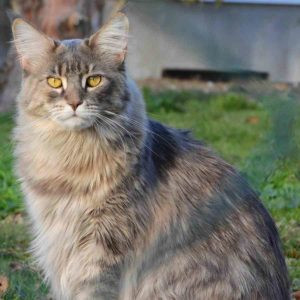 A majestic Maine Coon cat, known for its large size and shaggy coat
A majestic Maine Coon cat, known for its large size and shaggy coat
Famous for their impressive size, Maine Coon cats are one of the largest domestic cat breeds. They are amiable and gentle giants with a shaggy, water-resistant coat, perfectly suited for colder climates. Maine Coons are known for their intelligence, playful nature, and distinctive “chirping” vocalizations.
Manx
Manx cats are easily recognized by their defining feature: the lack of a tail, or a very short tail. Aside from this, they resemble a heavily-built domestic cat. When choosing a Manx, it’s crucial to find a breeder who understands the potential for spinal defects associated with the tailless gene and breeds responsibly to minimize these risks.
Norwegian Forest Cat
 A Norwegian Forest Cat with its thick, double coat and sturdy build
A Norwegian Forest Cat with its thick, double coat and sturdy build
The Norwegian Forest Cat, or “Wegie,” can sometimes be mistaken for other long-haired breeds until you know what to look for. Key characteristics include their thick, double coat, which is essential for harsh winters, and their distinctive triangular facial shape. They are sturdy, muscular cats with a gentle and adaptable temperament.
Ocicat
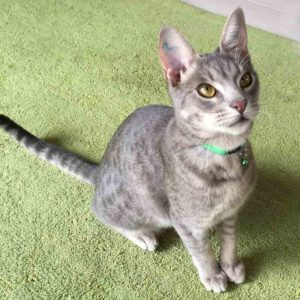 An Ocicat displaying its spotted coat pattern reminiscent of wild cats
An Ocicat displaying its spotted coat pattern reminiscent of wild cats
Ocicats are admired for their striking spotted coats that resemble those of wild cats like ocelots – hence their name. However, unlike some other spotted breeds, Ocicats have no wild cat ancestry in their recent lineage. They are entirely domestic cats known for their affectionate, playful, and outgoing personalities.
Oriental Shorthair
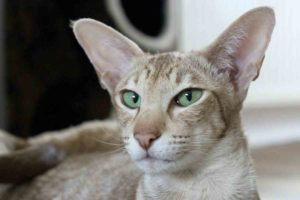 An Oriental Shorthair cat with its slender body and large ears
An Oriental Shorthair cat with its slender body and large ears
Sharing a similar body shape with Siamese cats, Oriental Shorthairs are elegant and slender cats with large, pointed ears. Unlike Siamese, they have green eyes and come in a vast array of coat colors and patterns, including tabby. Orientals are intelligent, curious, and known for being quite vocal and demanding of attention.
Persian
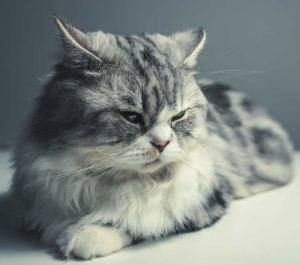 A classic Persian cat with its long, flowing coat and sweet expression
A classic Persian cat with its long, flowing coat and sweet expression
The Persian is renowned for its luxurious long coat, sweet face, and calm demeanor. They are one of the most easy-going cat breeds, known for their round heads, large, expressive eyes (typically yellow or copper), and thick, flowing coats that require daily grooming. Variations like the Exotic Shorthair and Chinchilla share Persian ancestry and characteristics.
Ragdoll
Ragdolls are known for their relaxed and docile nature, often going limp when held, hence the name “Ragdoll.” While they are laid-back, they are not inactive. Ragdolls are large, sturdy cats with semi-long fur and striking blue eyes. They often resemble a larger, more robust Birman in appearance. Ragdolls are affectionate and enjoy being around their families.
Russian Blue
 A Russian Blue cat with its silvery blue coat and green eyes
A Russian Blue cat with its silvery blue coat and green eyes
Often referred to as the “Russian Blue,” this breed is now also recognized in a white variety. Russian Blues are distinguished by their striking silvery-blue coats with a luminous sheen and their elegant, fine-boned frames. They have bright green eyes and a reserved yet affectionate personality. It’s important not to confuse them with blue tabby cats, as the Russian Blue’s coat is a solid, even color.
Scottish Fold
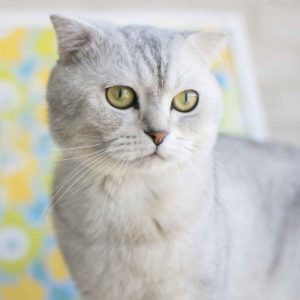 A Scottish Fold cat with its distinctive folded ears
A Scottish Fold cat with its distinctive folded ears
Scottish Fold cats are instantly recognizable by their unique folded ears, a result of a genetic mutation affecting cartilage. While the folded ears are considered endearing, this same genetic mutation can lead to serious health problems, including painful arthritis. Ethical concerns surround breeding Scottish Folds due to these health issues.
Scottish Shorthair (Straight-eared Scottish Fold)
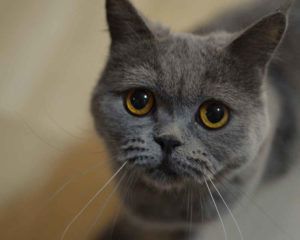 A Scottish Shorthair cat with its plush coat and charming personality
A Scottish Shorthair cat with its plush coat and charming personality
The Scottish Shorthair, also known as the straight-eared Scottish Fold or Scottish Straight, offers an ethical alternative for those who admire the Scottish Fold breed. These cats carry the same desirable personality and coat type as Scottish Folds but without the folded ears and associated health risks. They are essentially Scottish Folds that did not inherit the gene for folded ears.
Siamese
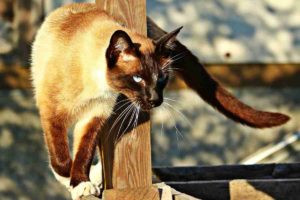 A Siamese cat with its classic pointed coat and blue almond-shaped eyes
A Siamese cat with its classic pointed coat and blue almond-shaped eyes
The Siamese is one of the most recognizable cat breeds, known for its striking “pointed” coat pattern and brilliant blue almond-shaped eyes. The classic “seal-point” coloration features dark ears, muzzle, tail, and legs contrasting with a pale body. Siamese cats are active, intelligent, vocal, and possess a regal yet affectionate disposition.
Somali
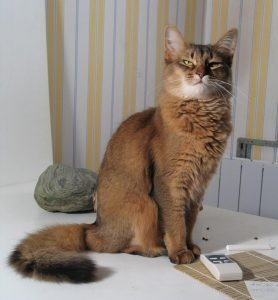 A Somali cat with its bushy tail and ticked coat
A Somali cat with its bushy tail and ticked coat
The Somali cat is essentially a long-haired version of the Abyssinian. Both breeds often come from the same breeders and share similar outgoing, confident, and playful personalities. Somalis are distinguished by their bushy tails and the same ticked coat pattern as the Abyssinian, but in a longer, flowing coat.
Sphynx
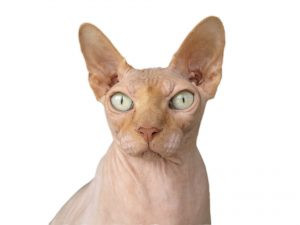 A Sphynx cat with its hairless appearance and wrinkled skin
A Sphynx cat with its hairless appearance and wrinkled skin
The Sphynx cat is famous for its hairless appearance, though they are not entirely without fur but rather have a fine down. Beyond their unique look, Sphynx cats are known for their charming and affectionate personalities. Owning a Sphynx requires understanding their specific needs, as they are more susceptible to temperature changes and require regular skin care.
Tonkinese
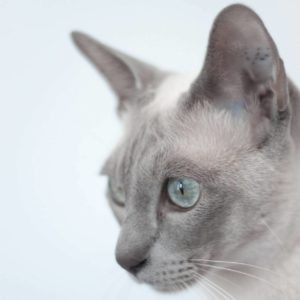 A Tonkinese cat with its blend of Burmese and Siamese traits
A Tonkinese cat with its blend of Burmese and Siamese traits
The Tonkinese breed is a hybrid resulting from crossing Burmese and Siamese cats. They exhibit traits from both parent breeds, striking a balance between the Burmese’s rounded features and the Siamese’s pointed pattern. Tonkinese cats are intelligent, social, and known for their playful and engaging personalities.
Turkish Van
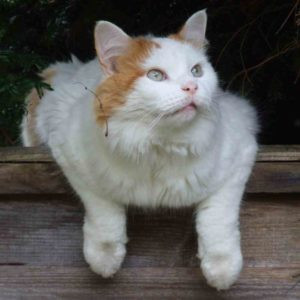 A Turkish Van cat with its distinctive Van pattern and love for water
A Turkish Van cat with its distinctive Van pattern and love for water
Turkish Vans are relatively rare, especially outside of their native region. They are often mentioned because many ginger and white cats in shelters are mistakenly labeled as Turkish Vans. True Turkish Vans are characterized by the “Van pattern” – color on the head and tail with a white body – and are known for their semi-longhaired coat and a unique trait: a love for water.

